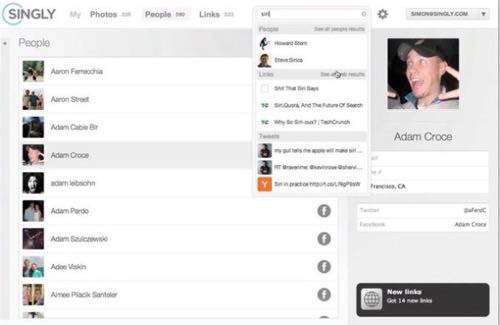You make data. A lot of it. From Web browsing to link sharing to photos published online, from phone bills to medical records to online banking – almost all of us produce an incredible amount of electronic data that slips right through our fingers – often into the gaping maw of a corporate world without our best interests in mind.

What if you could easily capture all that data yourself, though? What if you could use it like fuel for apps built for you to view, sort and take action based on all that data? What if you could offer selective access to outside parties to that data? That’s the vision behind the Locker Project, an open source personal data platform, and Singly, its corporate partner for hosted installs of the data lockers. Singly 1.0 launches to developers today at the Web 2.0 Summit (live at 2:40 PST). It’s got financial backing from the leaders of WordPress, TechStars and multiple VC firms and a knock-out team of famous developers building it. What does it look like? Check out the first screen shots below.
Screens at bottom of page.
Rock Stars Seek to Put You on Stage
We first wrote about Jeremie Miller – who created the Instant Messaging technology that almost all IM clients use in the world today – and his team building the Locker Project and Singly in February. (Creator of Instant Messaging Protocol to Launch App Platform for Your Life) Since then, Singly, from the corporate front to the non-profit Locker Project (like WordPress.com, or Automattic, is to WordPress.org), has expanded its team and hired a number of other well-known technologists. Most notably Matt Zimmerman, former CTO of Ubuntu.
Investors include David Pakman (Venrock partners), True Ventures (Toni Schneider, CEO of WordPress), David Cohen (CEO of TechStars), David Tisch (TechStars NYC), Josh Felser and Dave Samuel (Freestyle Capital), Tim Connors (PivotNorth Capital) and Kal Vepuri. Public advocates of what Singly is doing range from Tim O’Reilly and John Battelle to the CTO of Best Buy and Clay Shirky.
All of these people are advocating that, as John Battelle wrote yesterday about Singly, “we have to start taking control of our own identity and data,” because of the “value and benefits that will accrue to us and to society in a culture that values individual control of data.”
Here’s What’s Going Live Today
Singly 1.0 begins rolling out to developers today. Those first users will be able to build apps that search, sort and visualize contacts, links and photos that have been published by their own accounts on various social networks but also by all the accounts they are subscribed to there. Want to search the contents of every link shared by every person you’re subscribed to on Twitter (at least as far back as Singly can access)? Want to make a slideshow of all the Instagram photos your contacts have posted that have a certain hashtag in them? Or were on a weekend? Or whatever other criteria you can think of? Those kinds of things are possible now.
The apps will live on Github and will deploy on Singly, for now. You’ll be able to use someone else’s app, but only to visualize your own data. You can’t yet ask for permission to see someone else’s data. Below, a dashboard view of data being searched and then a selection of viewing apps for photos. Click the images to view them full screen.


What you see above is a few different apps. Right now they all live in Github and are pointed to from a wiki. More and more functionality will be brought directly into Singly in time, though, and by the next quarter the company says that front end developers will be able to write visualization apps directly against the platform with no need to build their own back end processing capabilities.
In the near term future, app developers will be able to access consumer-grade health tracking data from devices like Fitbit and financial data in the form of emailed receipts. Singly will build connectors, clean up and structure the data for apps to be built on top of.
Will people care? Will developers be able to build apps so compelling that end users will hook up Lockers to capture their data? It might be too geeky, but a whole lot of very smart people are putting their heads together to make it real.










